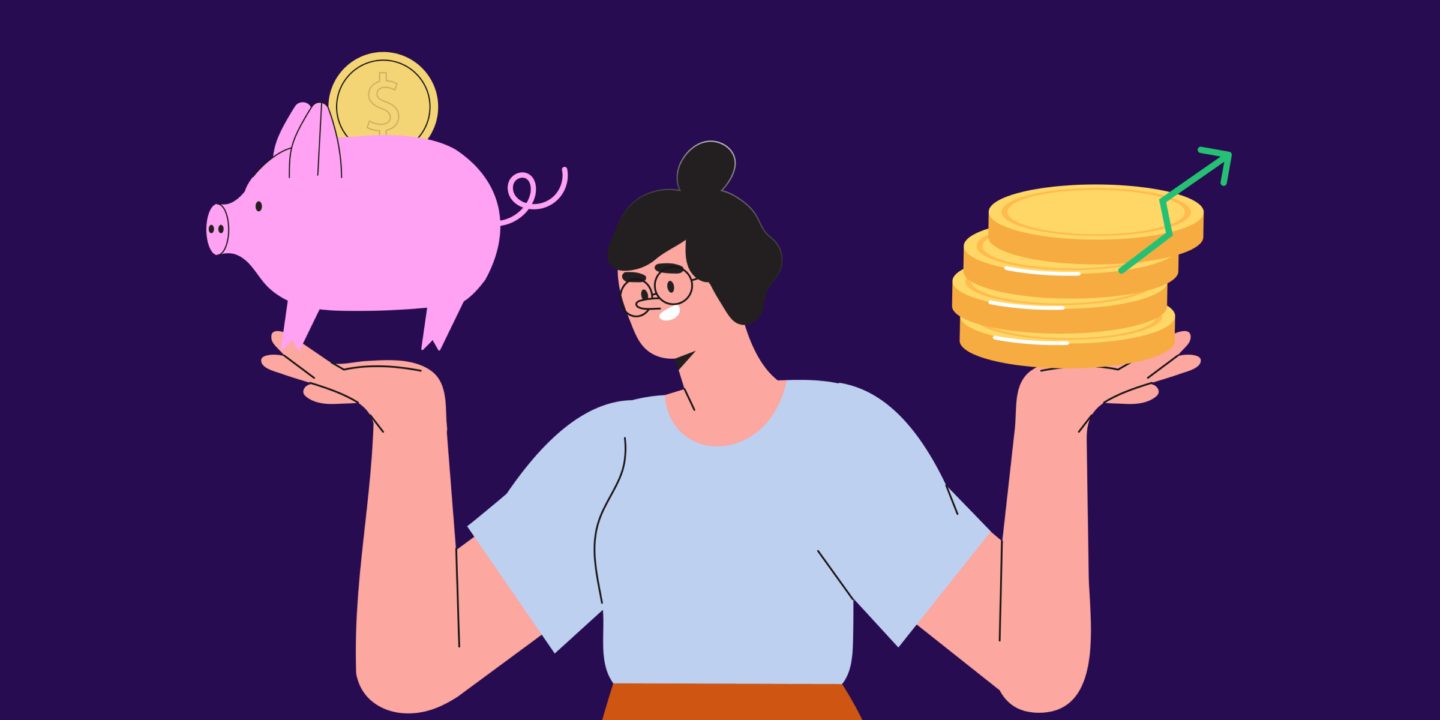
When you say the words ‘saving‘ and ‘investing,’ most people think it’s the same. People, especially those who’ve just started earning money, use them interchangeably. Hence, it is crucial for new investors to know the difference between saving and investing. This knowledge would enable them to identify when to save and when to invest.
For example, saving shouldn’t be the primary strategy if the financial goal is to build long-term wealth. Your savings account fund will be worth less due to the impact of inflation. On the other hand, in a deflationary environment, people who save will benefit in the short term as it allows them to save more money.
Difference Between Savings and Investment
Saving and investing differ in multiple dimensions, like objectives, return, liquidity, difficulty level, risk, time horizon, etc. However, they share a couple of similar characteristics —
- They’re vital tools to meet human needs and wants.
- Both require parking the money away for the future (from short-term to long-term).
Saving is putting money aside for future needs or emergencies. The saved money should be available immediately when you need it. In contrast, investing refers to buying assets that value over time and provide higher returns. However, this involves higher risk and lesser scope for liquidity.
The below table captures the difference between saving and investing.
| Parameter | Saving | Investing |
| Financial Objective | Emergencies or short-term goals | Long-term goals like retirement |
| Return Potential | Low | Potentially lower or higher |
| Risk Level | Almost none | Varies by investment — There is always the scope for losing some or all of your capital. Hence, investors must choose the products based on their risk tolerance. |
| Liquidity | High | Varies depending on the investment product |
| Products | Savings account, money-market accounts, certificate of deposits | Stocks, crypto, real estate, bonds, mutual fund, ETF |
| Time horizon | Short | Long (3 years or more) |
| Complexity level | Relatively low | High |
| Protection against inflation | Lesser Scope | Potentially higher scope |
| Taxation | Less | Depends on the time horizon and capital gains |
| Custodian | Banks | Brokerage firms |
Examples of Savings
1. Emergency fund
Most of the world’s population is just one unforeseen expense away from going bankrupt. If COVID-19 has taught us something, saving and maintaining an emergency fund would be essential. It helps handle medical emergencies, job loss, business loss, surprise bills, etc.
2. Parking money for a vacation or new gadgets
People save money to fulfill their immediate goals, like going on a trip or buying a brand-new phone.
3. Down payment for home or car
Though credit facility is available for purchasing high-ticket items like real estate or cars, usually a proportion of the item’s value has to be paid by the buyer as a down payment. Hence, saving money is an effective option to accumulate funds.
Examples of Investing
1. Retirement fund
Retirement is a complex topic considering the uncertainty of our global economic condition. Thus, investing in high-growth assets is mandatory to tackle inflation and live a comfortable retirement. Also, with recent trends like FIRE (Financial Independence Retire Early), many people are beginning to explore the investment world.
2. Long-term wealth fund
Investing is the most brilliant option for people who think beyond retirement and are willing to leave behind considerable wealth for future generations.
What Are the Pros and Cons of Saving and Investing?
You would notice that saving and investing have their identificatory features and characteristics. Similarly, both have their sets of pros and cons. Hence, it is necessary to be aware before choosing the right instrument to handle our finances.
The below table captures the pros and cons of saving and investing.
| Saving | Investing | |
| Pros | 1. Usually, a savings account has better accessibility to your funds. 2. Lower risk due to lesser volatility. 3. Fixed interest rates, which eliminates uncertainty. 4. Virtually no fee is charged for the savings account. | 1. Investment products offer higher returns over the long run. 2. Impact of inflation is lesser if the right asset is chosen and invested. |
| Cons | 1. Lower returns 2. As savings account has easy access, maintaining discipline would be difficult. People fall for impulse purchases, and so it would not be an easy task to be consistent in saving money. | 1. Higher volatility as investments are quickly impacted by the market crisis. 2. Scope for losing the whole investment capital. 3. Requires considerable time and skillsets to teach oneself to invest. 4. Higher fees and taxation compared to savings accounts. |
What Should You Choose? Saving or Investing
The answer to this question boils down to your present situation and future financial goals.
As a rule of thumb, you must save —
1. If you haven’t built an emergency fund. An emergency fund must cover at least three to six months’ expenses. Ideally, the fund should cover expenses for 12 months, especially for a single earner or self-employed individual.
2. If you have short-term goals (one to three years) like vacations, down payments, or any purchases. In these cases, investing isn’t the right option considering the time sensitiveness of the goals and the lack of guaranteed returns through investments.
As a rule of thumb, you can prioritize investing —
1. If you have made good progress in accumulating an emergency fund.
2. If you have paid off high-interest debts.
3. If you have long-term goals requiring a lot of cash (like retirement and college expenses for kids).
Therefore, saving should be the first move to build a financial cushion. After having one, you can start investing money for the long term to create a promising financial future. If you are looking to invest, check out Mudrex Coin Sets to add cryptocurrencies to your investment portfolio.
Conclusion
Savings are the starting point for anyone to handle day-to-day activities without financial stress. One shouldn’t skip savings and jump directly to investing. An emergency combined with poor macroeconomic conditions and illiquid investments leads to financial disaster.
Investing is an organic transition once the short-term goals are addressed. Investing in suitable asset classes keeps the money’s value intact against inflation, handles future expenses, and helps one to retire comfortably.
Hence, save and invest accordingly.
FAQs
1. How much should I keep in my savings?
The amount of money you should keep in your savings is usually based on your monthly expenses. An emergency fund of three to twelve months of expenses should be enough. This does not involve expenses beyond the essentials.
2. Does Inflation affect savings or investment?
Yes, it negatively affects both savings and investment funds. Owing to inflation, the value of money decreases over time. An annual inflation rate of 6% will erode the value by more than 80% in 30 years. Usually, saving products offer minimal returns due to their low risk and highly liquid nature. If not used immediately, the intrinsic worth of the fund depreciates.
When it comes to investing, let’s say if the invested money generates a 10% annual profit, it’s only the ‘nominal return,’ not the ‘real return.’ The real return has to be calculated after subtracting the inflation rate. Hence, investors must purchase assets that generate desirable post-inflation returns.




